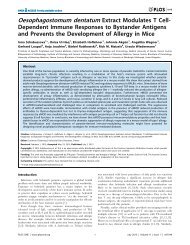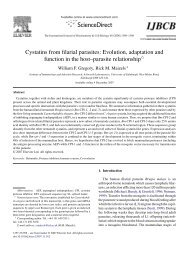Experimental Parasitology - Rick Maizels' Group - University of ...
Experimental Parasitology - Rick Maizels' Group - University of ...
Experimental Parasitology - Rick Maizels' Group - University of ...
Create successful ePaper yourself
Turn your PDF publications into a flip-book with our unique Google optimized e-Paper software.
Helminth parasites are widely recognised as masterful regulators <strong>of</strong> their host's immune<br />
response (Maizels, et al., 2004, Elliott, et al., 2007). In general, effective anti-helminth<br />
immunity depends on a strong Th2-type immune response (Anthony, et al., 2007, Allen and<br />
Maizels, 2011), but parasites divert or even suppress this pathway to ensure their survival.<br />
Defining the cellular and molecular basis for helminth immunomodulation will provide both<br />
new strategies for eradicating parasite infections (Hewitson, et al., 2009), and new<br />
understanding <strong>of</strong> the intimate co-evolution between helminths and the mammalian immune<br />
system (Maizels, 2009, Allen and Maizels, 2011).<br />
Among the many immunomodulatory helminth species, one <strong>of</strong> the most potent examples is the<br />
murine intestinal nematode Heligmosomoides polygyrus (Monroy and Enriquez, 1992), with a<br />
remarkable record <strong>of</strong> modifying a wide spectrum <strong>of</strong> host immune responses (Table 1). As well<br />
as notable effects on specific anti-parasite responses, modulation <strong>of</strong> systemic immune<br />
pathologies have been reported including intestinal food allergy (Bashir, et al., 2002), airway<br />
hyperresponsiveness (Wilson, et al., 2005, Kitagaki, et al., 2006), and bystander inflammatory<br />
responses to bacterial pathogens (Fox, et al., 2000). The particular value <strong>of</strong> the H. polygyrus<br />
model, compared to acute intestinal nematode infections such as Nippostrongylus brasiliensis,<br />
is that most strains <strong>of</strong> mice are unable to expel primary infections. This not only illustrates the<br />
parasite's immunosuppressive abilities, but provides a relatively stable system to analyse<br />
mechanisms <strong>of</strong> immune regulation in chronic infection. The parasitological basis <strong>of</strong> the model,<br />
and its value in exploring genetic variation in host susceptibility have recently been<br />
comprehensively reviewed (Behnke, et al., 2009); we will therefore focus primarily on the<br />
immunological aspects <strong>of</strong> this fascinating organism.<br />
H. polygyrus : the parasite<br />
H. polygyrus occurs naturally in wild mouse populations and has clearly evolved a high level <strong>of</strong><br />
adaptation to the murine immune system. It has a direct life cycle (Figure 1) in which infective<br />
larvae enter by the oral route and invade the duodenal mucosa, penetrating the entire<br />
muscular layer to reside beneath the serosal membrane. Around 8 days later, they return as<br />
adult worms into lumen, and following mating, egg production commences. Adult worms coil<br />
around villi and remain closely apposed to the proximal intestinal epithelium (Telford, et al.,<br />
1998). They are thought to feed on the epithelial cell layer (Bansemir and Sukhdeo, 1994)<br />
rather than penetrating it to access blood (unlike their near relatives, the hookworms).<br />
The laboratory isolate used in these studies is one which, reportedly, derives from a Californian<br />
Maizels et al Hydra Special Issue Page 3





